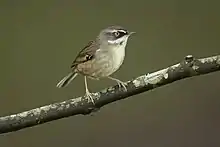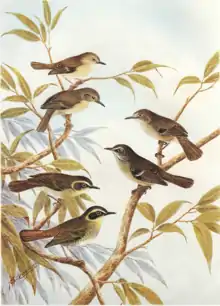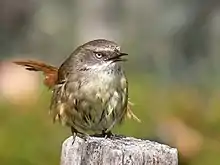White-browed scrubwren
The white-browed scrubwren (Sericornis frontalis) is a passerine bird found in coastal areas of Australia. Placed in the family Pardalotidae in the Sibley-Ahlquist taxonomy, this has met with opposition and indeed is now known to be wrong; they rather belong to the independent family Acanthizidae.
| White-browed scrubwren | |
|---|---|
 | |
| Scientific classification | |
| Kingdom: | Animalia |
| Phylum: | Chordata |
| Class: | Aves |
| Order: | Passeriformes |
| Family: | Acanthizidae |
| Genus: | Sericornis |
| Species: | S. frontalis |
| Binomial name | |
| Sericornis frontalis | |
It is insectivorous and inhabits undergrowth, from which it rarely ventures, though can be found close to urban areas. It is 11–14 cm (4.3–5.5 in) long and predominantly brown in colour with prominent white brows and pale eyes, though the three individual subspecies vary widely. Found in small groups, it is sedentary and engages in cooperative breeding. The larger Tasmanian scrubwren was formerly considered a subspecies of this species.
Taxonomy
The white-browed scrubwren was originally described by naturalists Nicholas Aylward Vigors and Thomas Horsfield in 1827. The specific epithet frontalis derived from the Latin frons "eyebrow".[2] It is now divided into three subspecies:
- S. f. frontalis, known as the white-browed scrubwren, is found in coastal eastern Australia from the New South Wales-Queensland border round to Adelaide in South Australia.
- S. f. laevigaster, known as the buff-breasted scrubwren, is found in coastal Queensland from the New South Wales border north to the Atherton Tableland.

S. humilis, the Tasmanian scrubwren, is found in Tasmania and Bass Strait islands and was formerly considered a subspecies of the white-browed scrubwren. It is larger at 13.5 cm long and lays larger eggs.
S. maculatus, known as the spotted scrubwren, occurs in coastal southern Australia, from Kangaroo Island and Adelaide westwards to Shark Bay in Western Australia. It is known to intergrade with the nominate subspecies where their ranges overlap.[3] Genetic analysis in a 2018 study of the family found that this taxon was more divergent from S. f. frontalis than the Tasmanian or Atherton scrubwrens and hence proposed its reclassification as a species.[4] It was reclassfied as a species in 2019.
Description
Mainland birds measure 11.5 cm (4 1⁄2 in) in length and olive brown upperparts (greyish brown in the spotted subspecies and dark brown in Tasmania), with prominent pale irises and a white brow. The throat is white with faint streaks in the subspecies frontalis and laevigaster and heavily spotted in maculatus. Ear coverts are grey in frontalis and black in laevigaster, and brownish in the other two subspecies. The underparts are pale, though buff in laevigaster. The thin bill is black. The Females are duller overall and generally have pale gray lores, whereas males have blackish lores. This allows most individuals to be reliably sexed in the field. The call is a loud high-pitched ts-cheer.[5]
Distribution and habitat
The species favours forested or scrubby areas with plentiful undergrowth, from which it rarely ventures. It is a common bird in bushland areas around Sydney.[6] It is sedentary.
Behaviour

Scrubwrens are predominantly insectivorous. They can be hard to spot but are very vocal and easy to localise. They occur in small groups of up to six birds and engage in cooperative breeding; namely that group members all help to feed and rear the young.[7]
Reproduction
Breeding season is June or July to November or December, with the nest a domelike structure of dried grasses and leaves, sticks, bark and ferns and feathers for lining. It is placed near or on the ground in dense cover. A clutch of two or three 20 x 15 mm eggs is laid; they vary from brownish-violet to brownish-white in colour with darker spots or blotches. The Tasmanian scrubwren lays larger eggs some 23 x 17 mm in dimensions.[8]
References
- BirdLife International (2012). "Sericornis frontalis". IUCN Red List of Threatened Species. 2012. Retrieved 26 November 2013.
- Simpson, D.P. (1979). Cassell's Latin Dictionary (5th ed.). London: Cassell Ltd. p. 883. ISBN 0-304-52257-0.
- Condon, HT (1951). "Notes on the birds of South Australia: occurrence, distribution and taxonomy". J. Aust. Ornithol. 20: 26–68.
- Norman, Janette A.; Christidis, Les; Schodde, Richard (2018). "Ecological and evolutionary diversification in the Australo-Papuan scrubwrens (Sericornis) and mouse-warblers (Crateroscelis), with a revision of the subfamily Sericornithinae (Aves: Passeriformes: Acanthizidae)". Organisms Diversity & Evolution. 18 (2): 241–59. doi:10.1007/s13127-018-0364-8. S2CID 46967802.
- Simpson K, Day N, Trusler P (1993). Field Guide to the Birds of Australia. Ringwood, Victoria: Viking O'Neil. p. 392. ISBN 0-670-90478-3.
- Roberts, Peter (1993). Birdwatcher's Guide to the Sydney Region. Kenthurst, New South Wales: Kangaroo Press. p. 132. ISBN 0-86417-565-5.
- Bell, HL (1983). "Cooperative Breeding by the White-browed Scrubwren Sericornis frontalis" (PDF). Emu. 82 (supplement): 315–16. doi:10.1071/mu9820315s. Retrieved 2007-10-21.
- Beruldsen, G (2003). Australian Birds: Their Nests and Eggs. Kenmore Hills, Qld: self. pp. 295–96. ISBN 0-646-42798-9.
External links
| Wikimedia Commons has media related to Sericornis frontalis. |
| Wikispecies has information related to Sericornis frontalis. |
- White-browed scrubwren factsheet Australian Museum online
- Birds in Backyards - White-browed scrubwren - with call recording

